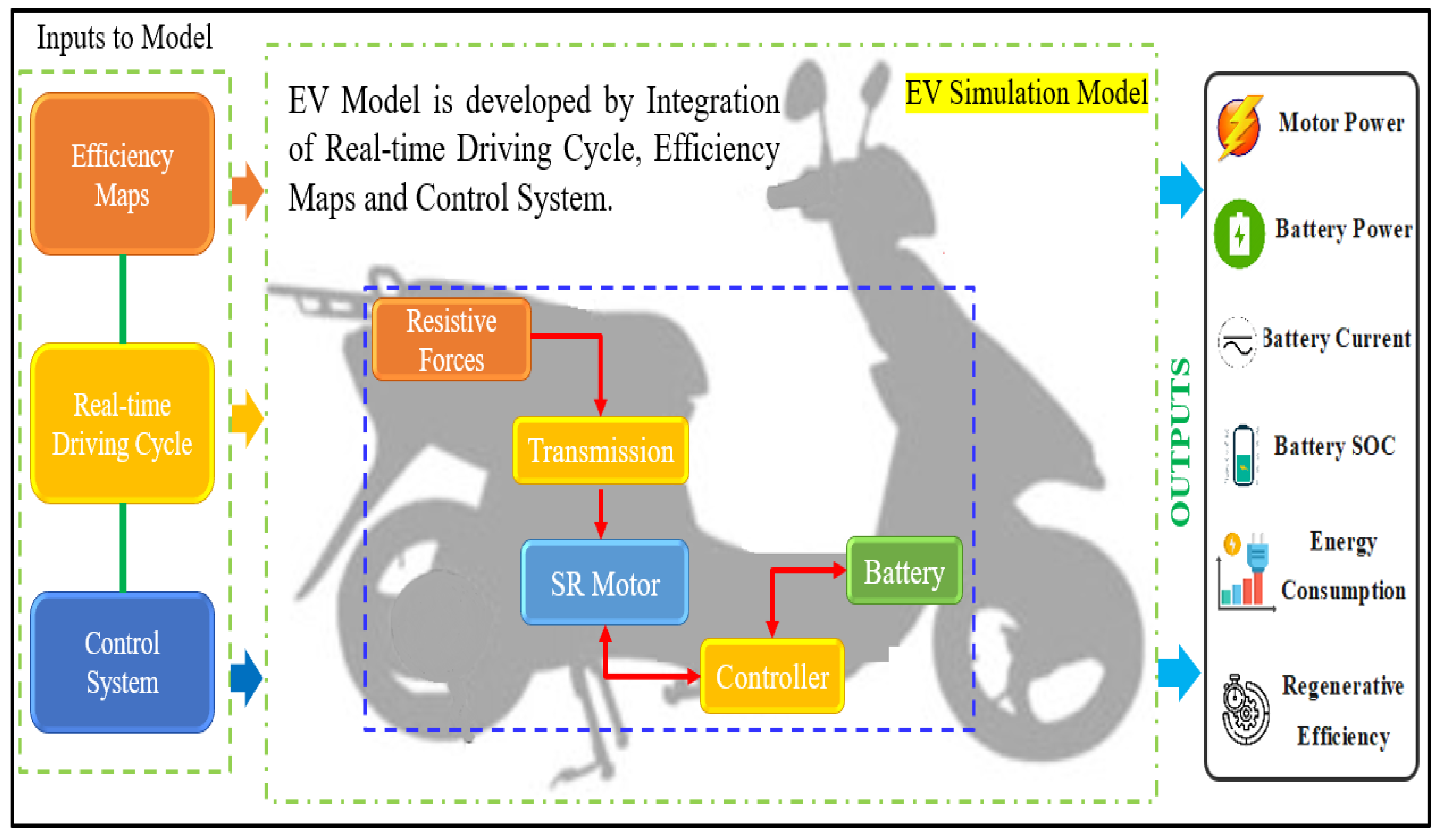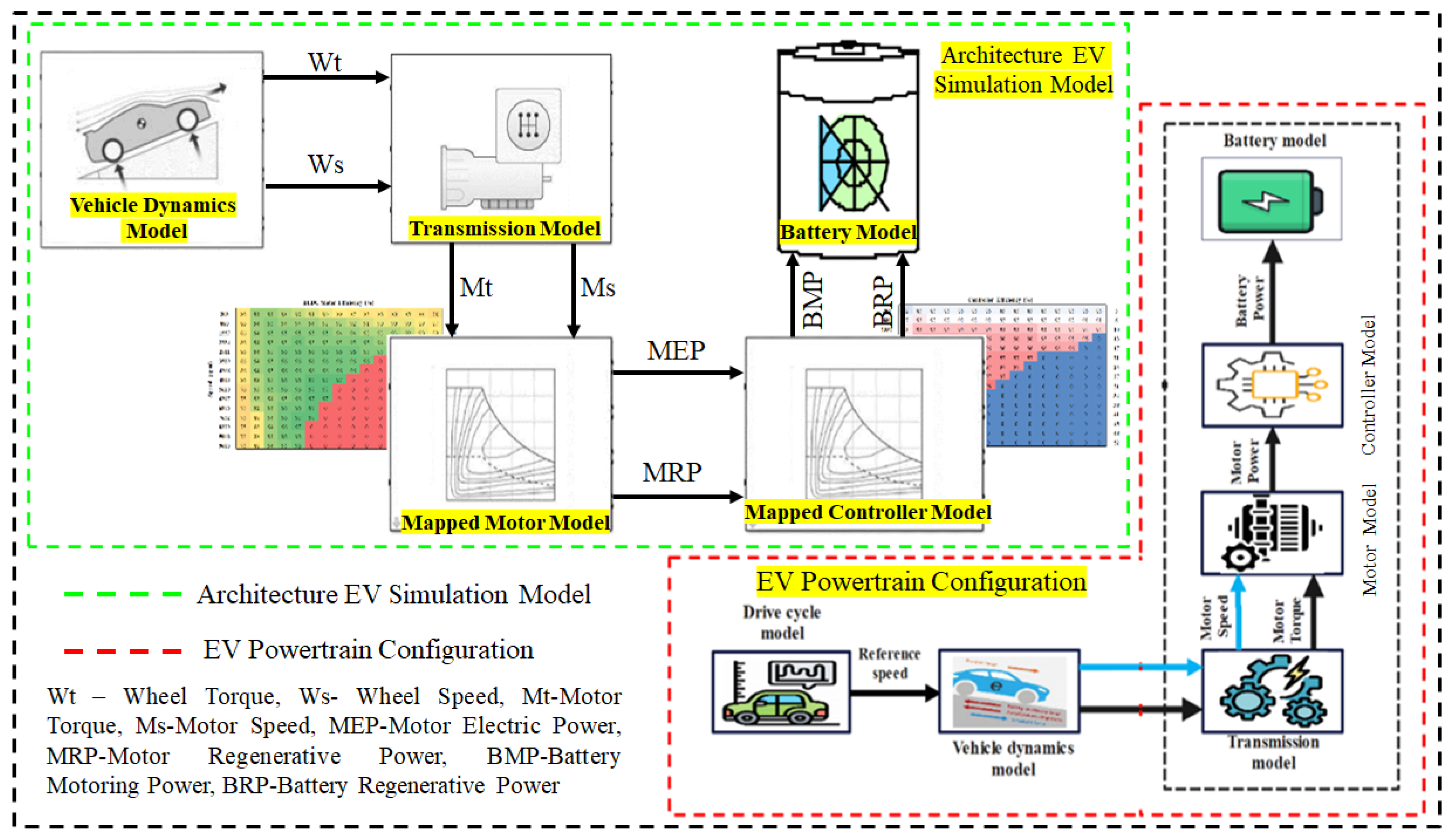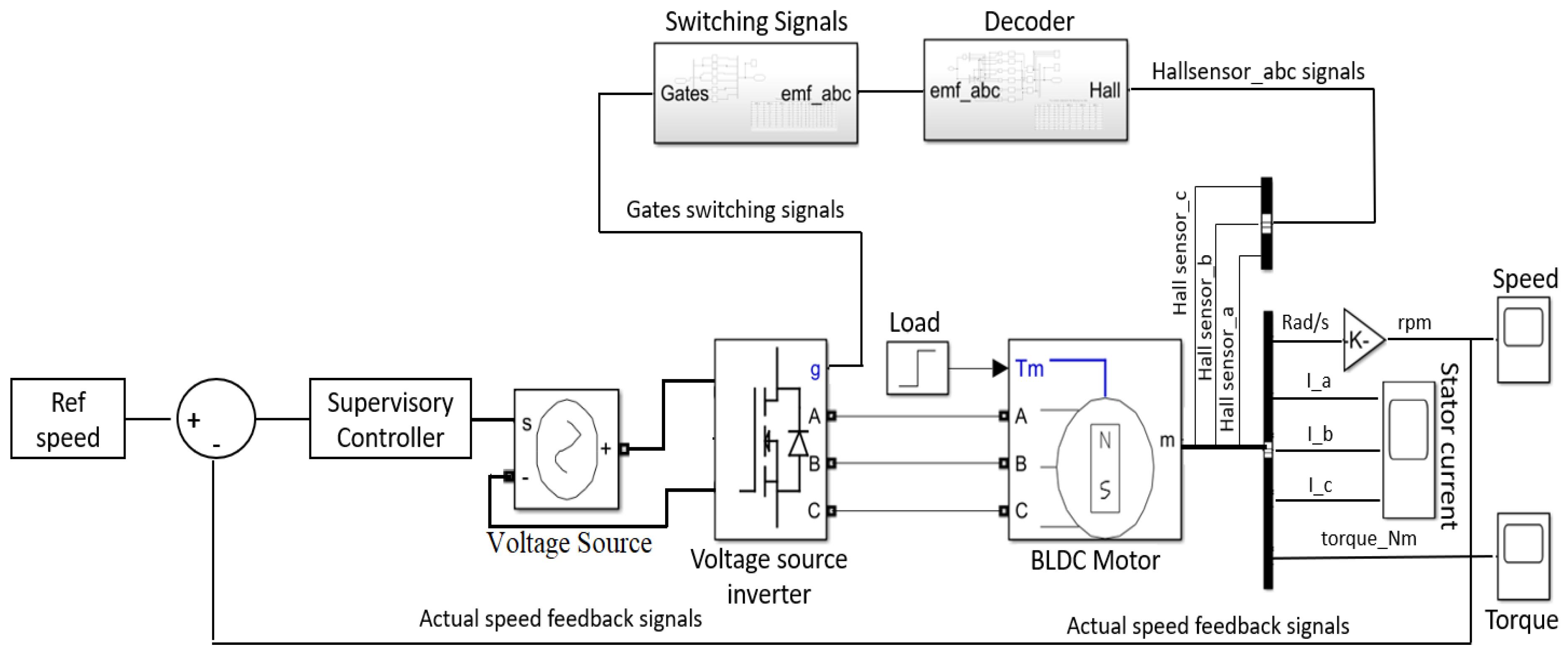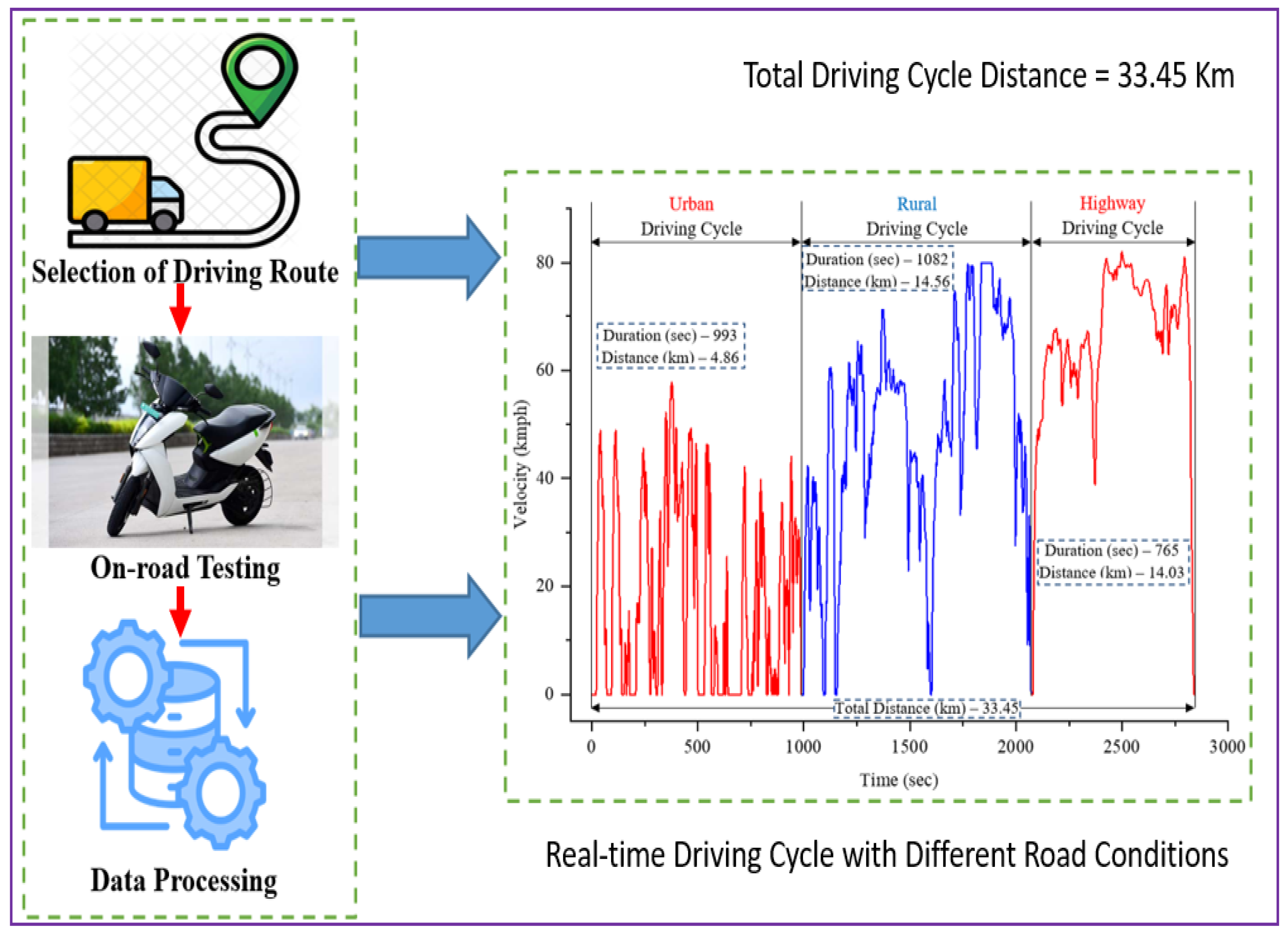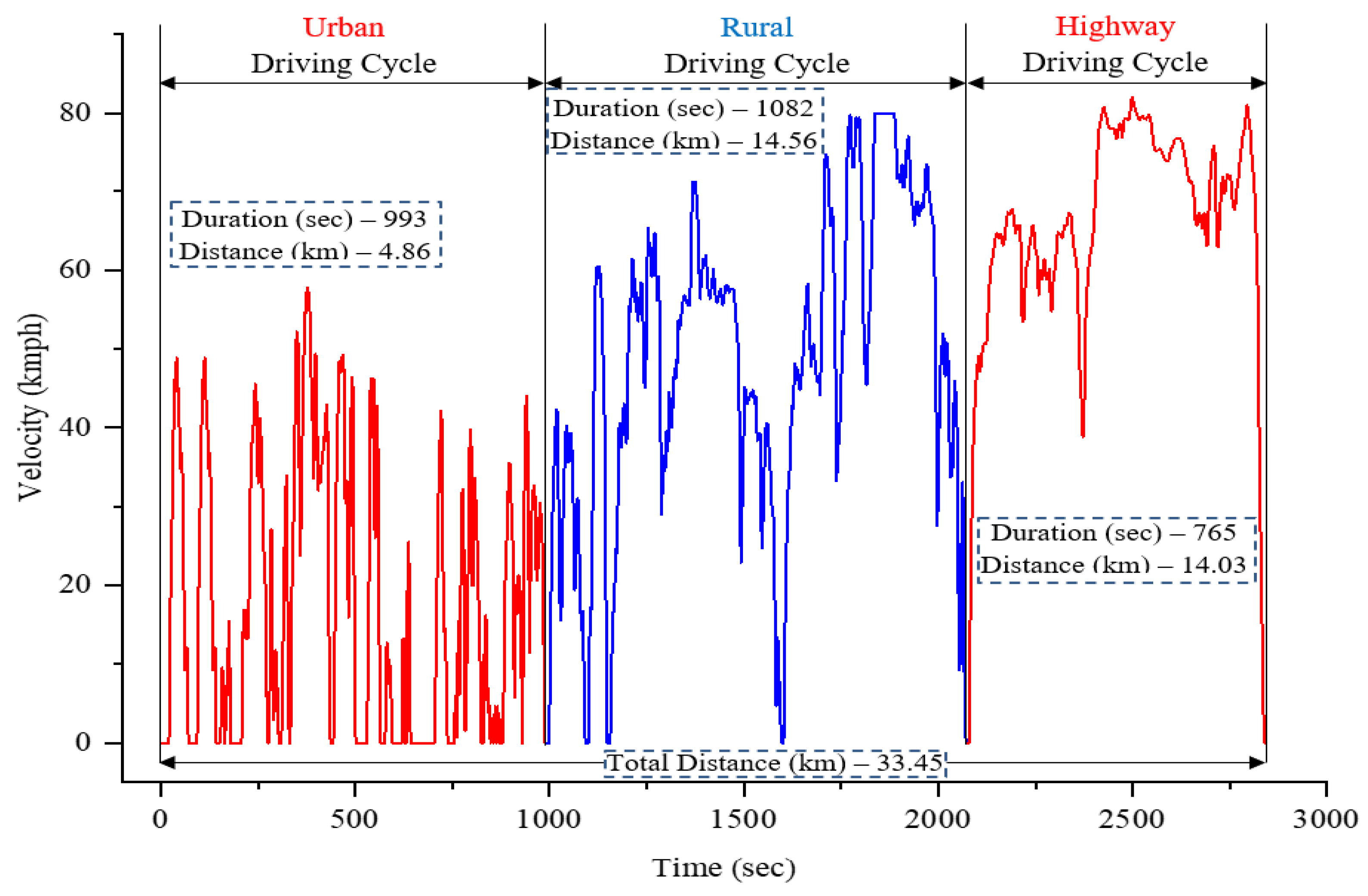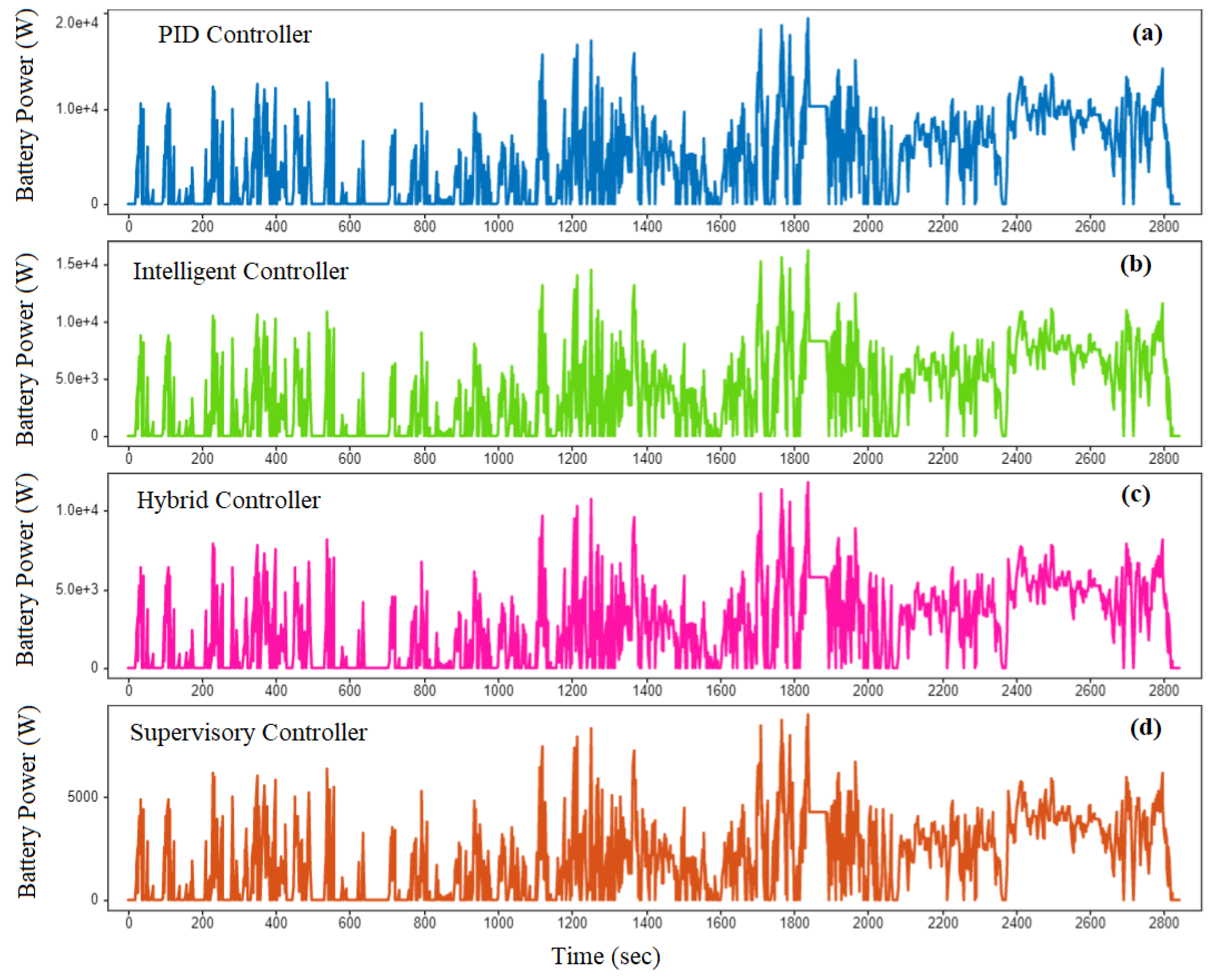1. Introduction
Electric vehicle (EV) adoption has been identified as the most optimal strategy for mitigating air pollution and greenhouse gas (GHG) emissions. Despite the increasing scarcity of fossil fuels and the ever-growing demand for the same, it is crucial that the automotive industry moves toward more environmentally friendly approaches [
1]. Hybrid electric vehicles (HEVs) and electric vehicles (EVs) have emerged as pivotal solutions for the current environmental hardships. EVs have several advantages such as negligible pollutants, high efficiency, and quiet driving experience with minimal environmental noise, with being battery powered being the main reason for this [
2]. However, to make EVs more acceptable and feasible for daily life, more advancements are needed, particularly in range extension, battery, and motor technology. Thus, the development of EVs and the assessment of their performance remain significant areas of interest for both the automotive sector and the research community [
3]. Moreover, it is crucial that the power required for propulsion must be analyzed under real-word operating conditions to evaluate EV performance and optimize the characteristics of the electric motor (EM), battery, controller, and converter. The actual operation of the vehicle is highly unpredictable, influenced by factors such as road conditions, energy consumption (EC), temperature, road grade, and driving behavior [
4,
5]. Therefore, standardized driving cycles (DCs) mandated by legislation are employed for EC assessments of EVs. Several DCs are used globally, which include the New European Driving Cycle (NEDC), the Worldwide Harmonized Light Vehicles Test Cycle (WLTC), the Federal Test Procedure (FTP), the Indian Modified Driving Cycle (IMDC), US06, etc. [
6,
7]. In the study conducted in [
8], the Urban Dynamometer Driving Cycle (UDDC) and NEDC were used to explore the impact of temperature on EC; this study revealed optimal EC values of 1.547 kWh and 1.648 kWh, respectively. Additionally, another study [
9] delved into the influence of the gearbox on the EC of EVs, finding that dual and continuously variable gearbox systems conserve more energy than single-gear transmissions. However, the energy usage of electric vehicles is primarily influenced by factors such as the dimensions of components, operational zones of powertrain elements (motor and battery), state of charge (SOC), driving distance, and so on. Addressing these issues requires an optimal modeling environment to enhance vehicle performance and EC under various real-time driving conditions. Also, ensuring the effectiveness of vehicle modeling and validation procedures requires considering critical design and control decisions. The EV propulsion system’s primary components include an electric motor (EM), battery, controller, and power converters. Various types of EMs, such as a brushless direct current (BLDC) motor, permanent magnet synchronous motor (PMSM), switched reluctance motor (SRM), and induction motor (IM), are employed in EV propulsion systems. The choice of EM and its associated controller significantly impacts EV performance. Therefore, to maximize performance and energy efficiency, considering performance needs, economic concerns, and the desired driving experience, appropriate motor and controller selection is crucial. As well, the practice of longitudinal vehicle platooning plays a crucial role in autonomous intelligent transportation systems by ensuring the maintenance of an optimal longitudinal spacing with preceding vehicles [
10,
11,
12,
13]. In this study, the SR motor has been chosen due to its beneficial characteristics, including high starting torque, efficiency, and power density. As a result, the creation of an effective energy management system (EMS) is a widespread priority, especially for EVs, aiming to distribute power demand efficiently while maintaining drivability and performance.
Presently, various energy management system (EMS) techniques aim to enhance electric vehicle (EV) performance across diverse real-time conditions; these include proportional–integral–derivative (PID) control, direct torque control (DTC), model predictive control (MPC), field-oriented control (FOC), fuzzy logic control (FLC), hybrid control, etc. These controllers can be characterized by their ability to achieve specific goals, such as minimizing energy consumption, optimizing dynamic responsiveness, and enhancing drivability. Although DTC offers superior torque control, especially for SR motors in EVs, it has drawbacks like torque and current ripples at low speeds, making it challenging to attain maximal vehicle performance and minimal energy consumption under real-time driving conditions [
14,
15]. To achieve high performance while maintaining the battery state of charge (SOC) around the desired value during depletion, the integration of DTC and FOC techniques into SR motors for EV propulsion is explored. However, using both controllers results in poor energy consumption and regenerative braking efficiency in various driving conditions [
16]. Consequently, the model predictive control (MPC) approach is employed to minimize EV energy consumption in real-time driving scenarios, forecasting future EV behavior and identifying optimal operating conditions. Despite its high computational costs and the need for prior knowledge of future driving actions, MPC fails to set appropriate battery discharge limits in real-time driving circumstances due to the complexity of EV systems [
17,
18]. In contrast, the proportional–integral–derivative (PID) approach gains attention for implementing an optimal EMS in real-world driving scenarios due to its reliability, short processing time, and efficient memory resource utilization. This approach dynamically adjusts control signals to enhance EV efficiency and driving range under various conditions. Optimization of PID variables using particle swarm optimization (PSO) and the genetic algorithm (GA) has shown improved transient response under real-time driving circumstances [
19]. An optimally adjusted PID controller aids in seamless transitions between diverse driving conditions, optimizing the recovery of energy during regenerative braking and improving the efficiency of the battery. Unlike traditional vector control approaches like DTC and FOC, the PID controller showcases its ability to reduce energy consumption (EC) and expand the operational range of electric vehicles (EVs) in dynamic situations. The tuning of PID parameters and energy preservation in unpredictable conditions is accomplished in [
20] through the utilization of battery state-of-charge (SOC) feedback and vehicle velocity. Despite its advantages in precise tracking of desired speed and torque for smooth acceleration and deceleration, PID control may struggle with nonlinearities and uncertainties in EV systems, impacting battery state-of-charge (SOC) estimation accuracy. Due to these reasons, the tuning of PID parameters is difficult in various transient conditions. Hence, designers have turned to intelligent controllers such as the fuzzy logic controller (FLC) and neural network (NN) to enhance EV performance under unpredictable conditions [
21,
22]. According to the literature, in order to regulate the nonlinear operations of electric vehicles (EVs), fuzzy logic control (FLC) utilizes a rule base and membership functions that incorporate input and output variables under different conditions. The precise calibration of the membership functions and rule base enhances accuracy in responses under diverse dynamic conditions. As a result, a fuzzy logic controller (FLC) proves more effective than a PID controller across various attributes like energy consumption (EC), state of charge (SOC), regenerative efficiency, etc., under changing speed and load conditions [
23]. Nevertheless, the nonlinear behavior of battery usage introduces multiple uncertainties into the battery SOC feedback system. Therefore, adjusting FLC settings to enhance electric vehicle (EV) performance becomes crucial, a topic that researchers have yet to fully address.
To tackle uncertainties in real-time battery state of charge (SOC) while driving, an innovative hybrid learning approach is proposed [
24]. This method combines fuzzy logic control (FLC) and proportional–integral–derivative (PID) techniques to govern electric vehicle (EV) transient error responses in various scenarios. The FLC’s role is to adapt PID parameters based on suitable rules and membership functions. This fusion of FLC and PID controllers is considered a ground-breaking hybrid strategy for reducing energy consumption (EC) and enhancing battery performance in diverse transient conditions. It offers the advantages of both accuracy and robustness, potentially improving battery health and lifespan. Furthermore, the hybrid approach is employed to enhance the performance of electric vehicles (EVs) across diverse road conditions (urban, rural, and highway). This is achieved by incorporating feedback from battery state of charge (SOC), vehicle speed, driving behavior, and the direction of current flow (regeneration) [
25]. While various hybrid control techniques have been applied in research studies to manage unknown parameters in nonlinear systems operating under limited conditions, their data-driven nature makes it challenging to establish suitable mathematical models for real-time driving situations. Neural networks (NNs) represent a type of control mechanism capable of adapting and learning through adjustments in neuron weights, sizes, relationships between layers, and activation functions [
26]. However, the precision of neural network control relies on both the quality and quantity of training data, with longer training times and potential issues outside the training domain. Recognizing the limitations of relying solely on a single learning approach, the integration of multiple control strategies (FLC and NN) through hybridization holds promise for achieving greater efficiency in real-time conditions [
27]. In this context, the adaptive supervisory self-learning controller (ASSC) emerges as a hybrid learning control approach, combining FLC’s reasoning mechanism with NN’s self-learning capability. NN improves the output decisions of the fuzzy inference system by defining optimal membership functions based on training data, aiming to enhance EV performance and minimize EC in real-time scenarios. The ASSC approach quickly reduces variations in speed, torque, and unfavorable chattering consequences under different conditions. Implementing a supervisory control technique improves the dynamic behavior of the EV concerning battery SOC, EC, battery C-rate, regenerative efficiency, etc. [
28]. Hence, the ASSC proves to be a more efficient control strategy than FLC and NN for managing battery state-of-charge (SOC) fluctuations in real-time scenarios. Implementing a nonlinear ASSC strategy holds the potential to improve the utilization profile of the battery SOC in electric vehicles (EVs), thereby extending their operational range. The ASSC approach is implemented with an SR motor used in EV applications under real-time conditions. In this study, the complete process of design and performance evaluation is carried out using the model-in-the-loop (MIL) simulation. MIL simulation is typically more efficient and computationally straightforward as it involves defining system behavior using a mapped experimental response technique, rather than relying on numerical representations to illustrate the behavior of the SR motor, controller, and battery systems. A model-based calibration technique is used for the development of an efficient SR motor and controller maps. This procedure encompasses several stages, including the design of experiments (DOE), model fitting, optimization, and lookup table generation. In the generation of maps (lookup tables), the application of experimental design enables a systematic exploration of the effects of the SR motor and controller behavior under diverse conditions, while minimizing the number of necessary test cases. This DOE-based approach systematically examines the impact of the SR motor and controller behavior under various conditions, reducing the complexity, time, and expense associated with map development. As the EV field evolves, advancements in control strategies will continue to be pivotal in achieving greater energy efficiency, prolonged battery life, and enhanced driving experiences.
Nowadays, automakers all agree that an effective energy management system (EMS) is necessary for EVs to operate optimally under real-time driving conditions. This study emphasizes the significance of a sophisticated EMS in enhancing the energy efficiency of EVs under practical scenarios. The numerical simulation of EV performance using various EMS techniques in real-time driving situations has been the subject of numerous studies. Moreover, precisely determining the driving range through an assessment of electric vehicles’ EC is crucial in eliminating driver anxiety. However, identifying the optimal discharge path for EVs is challenging due to factors such as driving actions, road grade, travel distance, and initial SOC variability. This study aims to accomplish the goal of efficient energy management and battery utilization in EVs by introducing an advanced self-learning control strategy. The objective of this is to bridge the gap between theoretical advancements and practical implementation by evaluating the effectiveness of the optimal EMS in an SR motor-equipped EV under real-world driving conditions. Despite numerous studies on EV performance with different control methods, there is a lack of comprehensive publications examining the performance characteristics of EVs with various energy management approaches. In this context, the objective of the present study aims to develop a mathematical model of an EV by integrating a mapped SR motor and controller efficiency with different EMS techniques. This research paper introduces energy management strategies such as proportional–integral–derivative (PID) control, fuzzy logic control (FLC), hybrid control, and adaptive supervisory self-learning controllers (ASSCs) to minimize energy consumption and extend EV range under diverse operating conditions. The ASSC approach is found to enhance the dynamic behavior of EVs compared to traditional approaches like PID, FLC, and hybrid, considering parameters such as battery SOC, energy consumption, battery C-rate, and regenerative efficiency. A novel aspect of this work is the development of a real-time driving cycle in urban, rural, and highway conditions to assess the effectiveness of EVs in practical operating scenarios. Additionally, this research paper employs an innovative methodology to create DCs and efficiency maps of the controller and SR motor under real-time conditions. These maps are then incorporated into the EV model to evaluate various performance parameters, including energy consumption, regeneration efficiency, motor power, battery SOC, battery current, and C-rate, using different energy management controllers. This study concludes by comparing the performance of various energy management controllers (PID, fuzzy, hybrid, and ASSC) across the beforementioned parameters to validate the real-time performance superiority of the proposed adaptive supervisory self-learning controller. It is anticipated that the ASSC approach will significantly improve battery utilization, ultimately enhancing the real-time operational performance of electric vehicles. The specified objectives of this study aim to provide readers with knowledge and a critical perspective on the design and development of effective energy management controllers for electric vehicles while also suggesting potential areas for future research.
6. Simulation and Validation of the Developed SR Motor and Controller Maps with the Real-World Driving Cycle
The driving cycle source is necessary to simulate the EC and battery discharge behavior. In this study, a real-time DC is created for all road situations, including urban, rural, and highway.
Figure 8 shows the experimental process for a generating real-time DC in diverse driving situations, including urban, rural, and highway. This study examines the real-time DC design and development process, as well as route selection, trip timing, and experimental technique. The first and most crucial step in creating a driving cycle is deciding on a route [
37]. The driving route in Vellore, India, is determined based on knowledge of local road and traffic conditions, as seen in
Figure 9.
Table 5 discusses the developed driving cycle characterizations for different driving routes. The selected driving route comprises all three types of road conditions: rural, highway, and urban. The whole length of the driving trip is around 33.45 km with different real-time road conditions.
Furthermore, the electric two-wheeler is used to develop a real-time driving cycle for a variety of road situations.
Table 1 shows the selected vehicle specifications. The chosen EV is connected to a microcontroller and mobile phone GPS. The microcontroller contains the vehicle’s speed as well as battery and motor performance statistics under different real-time driving conditions. In addition, the data collected from the mobile GPS include vehicle speed and location with X, Y, and Z directions along the different driving routes such as urban, rural and highway. During driving, the microcontroller stores the real-time data for different real-time driving conditions. Following that, a real-time DC is created using the collected data, with different driving routes including urban, rural, and highway.
Figure 10 shows the profile of the created real-time driving cycle for different road conditions. A driving cycle is a set of data points that show the relationship between a vehicle’s speed and time. It is used to evaluate the performance of cars in several aspects including fuel efficiency, electric vehicle range, and harmful emissions. Furthermore, the established real-time driving cycle is used with the EV simulation model to estimate performance metrics such as power, C-rate, EC, battery discharge behavior, regeneration efficiency, and so on. Finally, this study integrates a real-time DC, a BLDC motor, and various energy management controller (such as PID, fuzzy, hybrid, and supervisory) efficiency maps with an EV simulation model to analyze the motor and battery’s performance in real-world driving situations.
8. Conclusions
This study has been conducted to optimize the energy consumption of EVs by developing a robust energy management controller and testing it under various real-time driving conditions. This study employs various methodologies to develop the efficiency maps, the EV model, and a real-time DC which are then combined with the developed EMCs, such as PID, intelligent, hybrid, and supervisory, to enhance the EV performance under real-time driving conditions. A MATLAB/Simulink-based mathematical model is formulated for an EV with an SR motor. Through a novel experimental approach, the efficiency maps of the motor and various EMCs are developed. These maps are then integrated into a model-in-loop (MIL) EV test platform to assess the performance of different EMCs in EVs under real-time driving conditions. Further, for the validation process, a real-time DC is implemented for different types of road conditions, which include urban, rural, and highway roads. This DC is linked to the MIL-based EV test platform real-time analysis of energy consumption and battery discharge patterns. The present study concludes by simulating the EV model using various EMC efficiency maps and the real-time DC to analyze parameters like motor power, battery power, C-rate, energy consumption (EC), state of charge (SOC), regenerative efficiency, and more. The validation and interpretation outcomes of this research paper are summarized below.
To carry out the EV simulation, the necessary efficiency maps of the SR motor and the controllers are developed under real-time conditions. For the validation of the model, a real-time driving cycle is designed to encompass diverse road conditions, including urban, rural, and highway scenarios.
The supervisory controller performs better than conventional controllers as it exhibits less variations, based on the SR motor and battery performance characteristics in controllers in urban, rural, and highway driving conditions, as presented in
Table 6.
The proposed supervisory self-learning controller achieves significantly less energy consumption (44.67 Wh/km) compared to PID (97.21 Wh/km), intelligent (85.63 Wh/km), and hybrid (60.14 Wh/km) controllers under varying real-time operating conditions. This suggests an improvement in battery utilization behavior and operating range for the EV under dynamic conditions.
The end-of-trip state-of-charge (SOC) drop for the proposed supervisory controller (59.1%) is notably lower than that of the PID (3.6%), intelligent (21.5%), and hybrid (44.9%) controllers across different road conditions. Consequently, the supervisory controller enhances battery efficiency and overall EV performance in real-time conditions.
The regenerative efficiency of the PID, intelligent, hybrid, and supervisory controllers is recorded as −21.81, −27.73, −41.64, and −58.28 Wh under varying road conditions. Notably, the proposed supervisory controller exhibits greater energy recovery compared to the other conventional controllers. This improvement contributes to enhanced battery consumption behavior and extended driving range under real-time conditions.
The current study improves the performance of electric vehicles (EVs) under real-time driving conditions through the implementation of the proposed adaptive supervisory self-learning controller. It not only reduces energy consumption (EC) but also enhances the driving range across various road conditions. Although the potential limitation of the suggested controller is its heavy reliance on training information, impacting its overall performance, it can be overcome by leveraging advanced controllers like the multi-adaptive neuro fuzzy inference system (MANFIS). Furthermore, specialized optimization techniques could be employed to train the data. Investigating these alternatives could contribute to achieving a more stable and effective performance for the proposed controller.
